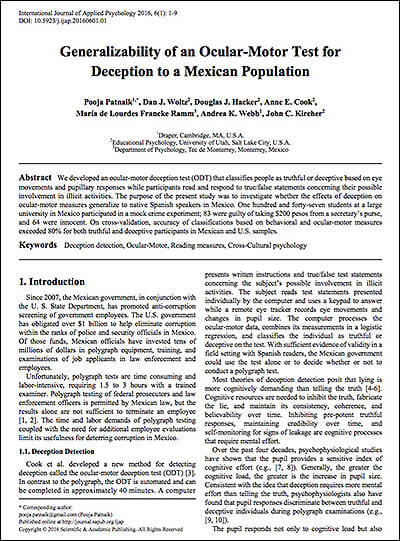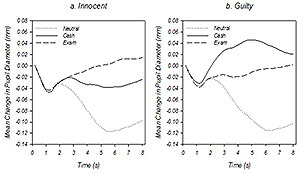New Study Shows Accuracy of Converus’ Lie Detection Technology EyeDetect Remains Unchanged Between English and Spanish-Speaking Participants
The just-released International Journal of Applied Psychology is a peer-reviewed article on the accuracy and effectiveness of the EyeDetect technology with native Spanish-speaking participants from a university in Mexico. It found the accuracy at about 85 percent, the same a previous peer-reviewed journal found with English speakers.

A just-release peer-reviewed study in the International Journal of Applied Psychology shows EyeDetect’s accuracy remains at about 85 percent regardless whether the participants are English or Spanish speaking.
LEHI, Utah – Feb. 25, 2016 – A new peer-reviewed study of Converus’ EyeDetect lie detection technology shows its ocular-motor test (ODT) for deception to be 85 percent accurate and concludes that accuracy is the same with English and Spanish speaking participants.
The article, “Generalizability of an Ocular-Motor Test for Deception to a Mexican Population,” published in the International Journal of Applied Psychology, states, “…[EyeDetect] correctly classified approximately 85% of truthful and deceptive participants.”
The accuracy results from this new study match those from previous field studies on EyeDetect which were published in the September 2012 issue of Journal of Experimental Psychology: Applied. That article also concluded EyeDetect “correctly classified 85% of participants as either guilty or innocent.”
“This study reconfirms the accuracy of EyeDetect to be comparable to the top accuracy rates for the polygraph as indicated in the American Polygraph Association meta-data analysis of 2012,” said Converus President and CEO Todd Mickelsen. “But when screening larger groups of individuals — like Syrian refugees or visa applicants — EyeDetect is a better choice because each test only takes 30 minutes and results are delivered within 10 minutes.”
However, when EyeDetect is used in conjunction with the polygraph, and when both tests have the same result, accuracy reaches about 97 percent, says Mickelsen. Converus has numerous polygraph companies signed on as partners — including Lafayette Instrument Company, the world’s largest manufacturer of polygraph instruments.
EyeDetect is the first ODT lie detection technology. It uses an infrared camera to monitor involuntary eye behavior — including pupil dilation, blink rate and fixations — to detect deception while a person answers true/false questions on a computer screen.
Since 2007, the Mexican government, along with the U. S. State Department, has promoted anti-corruption screening of government employees. More than $1 billion has been given by the U.S. government to help eliminate corruption within the ranks of police and security officials in Mexico. Mexican officials have used a large portion of this funding to invest in polygraph equipment, training, and examinations of job applicants in law enforcement and employees.
But polygraph examinations, the long-time standard for lie detection, are more time consuming and labor intensive than EyeDetect. Each exam requires a trained examiner, take one and a half to three hours to conduct, and reports can sometimes take hours to prepare. Most polygraph examiners conduct two or three exams a day, whereas an EyeDetect proctor can administer up to about 15 tests daily. Ironically, two of the scientists on the Converus Science Team, Drs. David Raskin and John Kircher, are not only world-renowned polygraph experts, but also credited with inventing the computerized polygraph.
This new research study was based on a mock crime study conducted at a Mexican university with native Spanish-speaking participants. According to the article, this “study failed to reveal any evidence of meaningful differences between Mexican and U.S. participants on any behavioral or ocular-motor measure of deception. Despite differences in culture and language, behavioral measures of response errors and response times did not distinguish between the Mexican and U.S. settings, nor did reading patterns or pupil responses… The uniformly high levels of decision accuracy achieved by the logistic regression models in Mexican and U.S. samples are indications of the robustness of the effects of deception on ocular-motor measures, as well as the stability of covariance structures among the measures across settings.”

These charts show the mean change in pupil diameter for 8 seconds following item onset by item content and guilt condition.
“We’re confident that when EyeDetect’s accuracy is measured using real criminals, as opposed to a mock crime, the accuracy will be in the 90th percentile,” said Mickelsen.
Research related to eye behavior isn’t new. Over the past four decades, psychophysiological studies have shown that the greater the cognitive load, the greater the increase in pupil size. The ODT is based on the premise that it’s more difficult to lie than to tell the truth, and that deception can be associated with a strong emotional response. Regarding this, the new study says, “If these ideas are correct, effects of language on the diagnostic validity of our reading measures may be too small to matter. On the other hand, the proposed theoretical framework would predict effects of culture on the deceptive context created in a mock crime experiment if there were differences between the cultures in moral development. If the theft of money was more reprehensible in one culture than another, commission of the crime might evoke a stronger emotional response that could affect one or more of the outcome measures. However, there was no evidence of such an effect in the present study.”
The International Journal of Applied Psychology study was peer reviewed by Pooja Patnaik, Dan J. Woltz, Douglas J. Hacker, Anne E. Cook, Maria de Lourdes Francke Ramm, Andrea K. Webb, and Kircher. Of those, Woltz, Hacker, Cook and Kircher are also members of the Converus Science Team.
Companies and government agencies throughout Latin America have been using EyeDetect for pre-employment screening of job candidates and periodic testing of current employees since late 2014. Converus recently began offering EyeDetect to the U.S. market, claiming it’s not only ideal for screening job candidates in government, law enforcement and corrections, but also visa applicants, immigrants, and parolees.
For more information, visit www.converus.com.
# # #
About Converus
Converus (“with truth”) is committed to providing trustworthy credibility assessment solutions. Its flagship product, EyeDetect® — a product first conceived in 2002 — is the first ocular-motor deception detection solution. It’s an accurate, cost-effective, efficient, secure and nonintrusive method that detects deception in 30 minutes by analyzing eye behavior. The same scientists credited with computerizing the polygraph in 1991 developed EyeDetect. It’s a new way for organizations to manage risk and ensure workplace integrity, and for law enforcement agencies and governments to detect deception. Ultimately, it helps protect countries, corporations and communities from corruption, fraud and threats. The company is headquartered in Lehi, Utah, USA. For more information, visit www.converus.com.
_____________________________________________
Press Contact: Jeff Pizzino, APR / +1 480.606.8292

